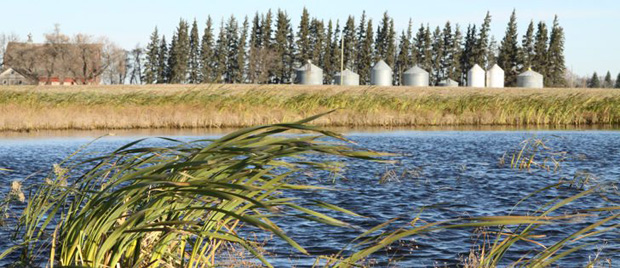The recently released Manitoba Green Plan is dominated by plans for a carbon tax and arguments that the Made-in-Manitoba scheme is better than the Federal system. Nevertheless tucked away in the latter half of the document is a section focused on what our government thinks needs to be done to manage surface waters in southern Manitoba.
Much of what is proposed is good. It builds on ideas put forward by the previous government around the need to better regulate surface water drainage: increasing the regulation of works that are likely to have a significant impact while streamlining applications to carry out minor works such as cleaning out a ditch or replacing a culvert. Unfortunately this Green Plan is light on execution detail. A key detail left out is what should happen if an applicant does hear back within 10 days. Is he then free to proceed with the work. Just imagine how things could go wrong if insufficient resources are put into administering the scheme.
The Plan seems to assume that problems with flooding can be solved mainly by protecting and restoring Manitoba’s wetland ecosystems. Meanwhile [according to the Plan] drainage of other parts of the landscape can continue. For example, it overlooks the role vegetation has in reducing flooding; snow melts more slowly in forested areas than in open fields. This serves to dampen the peak spring flow. Similarly, the ability of sustainably managed permanent grassland to increase infiltration and storage water is overlooked.
The economics of improving water retention are hazy. The GROW program is offered as a means of persuading landowners to store water on their land, perhaps using wetlands that have previously been drained. But in many areas this land has become extremely valuable and may even been built upon. Some landowners may be willing and able to give up income to protect the wider community, but many cannot afford this. Unless the GROW program is able to offer compensation for lost income, it’s doubtful that the land area retaining water will grow any faster than it has under the existing conservation district program. Without careful planning, water retention may actually result in more marginal land being farmed than before.
Algal blooms in Lake Winnipeg, the result of human caused phosphorous pollution, has gained international attention. The traditional method of treating wastewater does nothing to remove nutrients. Chemical treatments can be added to lock up phosphorous but the resulting sludge must then be landfilled. Using vegetation beds to capture nutrients was pioneered by the RM of Dunnotar and has been adopted by the village of St. Pierre-Jolys and the RM of La Broquerie. This shows some promise.
The issue of nutrients from agriculture is addressed , however it is unlikely that the solutions offered are adequate. The fundamental problem is not being addressed: too much poop on too little land. The poop produced by the current livestock in southeastern Manitoba is approximately equivalent to the poop produced by the city of Winnipeg. The situation is made worse because much of that manure in the southeast, is spread on organic soils. Unlike the clay soils of the Red River valley, organic soils, that become available when forests are cleared and swamps drained, don’t hold phosphorous. Nevertheless it is these very areas that are targeted for barn expansion.
The GROW program appears to be the main focus of any offered solution, but economics and topography are likely to make the required effect very difficult to achieve.
Overall this Made-in-Manitoba Green Plan is a useful document. It builds significantly on work that has already taken place with respect to flood mitigation and nutrient management. But it is not yet a plan for how we will move forward with the management our surface waters. It is a series of proposals, and it is uncertain how the methods proposed are going to achieve their objectives.
Check out the plan online and respond. Our government is asking us to do that.




